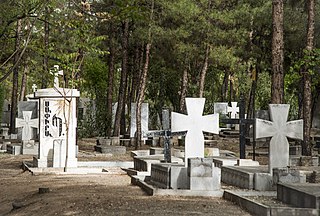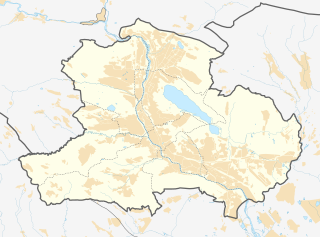 W
WThe Armenian cemetery in Julfa was a cemetery near the town of Julfa, in the Nakhchivan exclave of Azerbaijan that originally housed around 10,000 funerary monuments. The tombstones consisted mainly of thousands of khachkars – uniquely decorated cross-stones characteristic of medieval Christian Armenian art. The cemetery was still standing in the late 1990s, when the government of Azerbaijan began a systematic campaign to destroy the monuments.
 W
WDoulab Cemetery is a historical cemetery situated in the eastern suburbs of Tehran, Iran. One of the most important Christian cemeteries, it consists of five sections:Armenian Apostolic Eastern Orthodox Roman Catholic Armenian Catholic Assyrian
 W
WThe Armenian Pantheon of Tbilisi, also known as Khojivank or Khojavank, is an Armenian architectural complex in north-eastern part of Avlabari district of Tbilisi, Georgia. Many notable Armenian writers, artists and public figures are buried there.
 W
WKomitas Park and Pantheon is located in Yerevan's Shengavit District, on the right side of the main Arshakunyats Avenue, in Armenia. It was formed in 1936 after the demolition of the "Mler" cemetery and its historic chapel.
 W
WThe Armenian Cemetery of Moscow is an Armenian historical cemetery in Moscow, Russia It is located in the Krasnaya Presnya district, not far from Vagankovo Cemetery. The cemetery was established in 1804 by the initiative of Minas Lazarev, the leader Moscow’s Armenian community, who also initiated the construction of the Surb Harutyun Armenian church (1808–1815). The Lazarev family crypt is located under the church. The cemetery and the church are under state protection. Among the state-protected monuments are the obelisk on A.A. Loris-Melikov's tomb (1844), Ananov's tombs, khachkar on D.S. Melik-Beglyarov's tomb (1913), and the modernist gravestone for Nikolai Tarasov sculpted by Nikolai Andreev. The Armenian Cemetery is also the resting place for the remains of people who were not of Armenian descent.
 W
WNew Julfa Armenian Cemetery is a historical cemetery near New Julfa Armenian quarter of Isfahan, Iran.
 W
WNor Burastan Cemetery is the major Armenian cemetery located in southeast of Tehran. It was established in 1974 and has a chapel by the name of St. Stephen (hy).
 W
WNoratus cemetery, also spelled Noraduz, is a medieval cemetery with many early khachkars located in the village of Noratus, Gegharkunik Province near Gavar and Lake Sevan, 90 km north of Yerevan.
 W
WThe Pangaltı Armenian Cemetery was located in the Pangaltı quarter of Istanbul near Taksim Square and originally belonged to the Surp Agop Armenian Hospital. In the 1930s it was demolished and was replaced with the Taksim Gezi Park, Divan Hotel, Hilton Hotel, Hyatt Regency Hotel, and the TRT Radio Buildings.
 W
WThe Şişli Armenian Cemetery is an Armenian cemetery in the Şişli district of Istanbul, Turkey which is operated and served to the Armenian community of Turkey.
 W
WSmolensky Cemetery is the oldest continuously operating cemetery in Saint Petersburg, Russia. It occupies a rectangular parcel in the western part of Vasilievsky Island, on the bank of the small Smolenka River, and is divided into the Orthodox, Lutheran, and Armenian sections.
 W
WVera cemetery is cemetery in Vera district in Tbilisi, Georgia.
 W
WYerablur or Yerablur Military Pantheon is a military cemetery located on a hilltop in the outskirts of Yerevan, Armenia. Since 1988, Yerablur has become the burial place of Armenian soldiers who lost their lives during the Nagorno-Karabakh conflict.